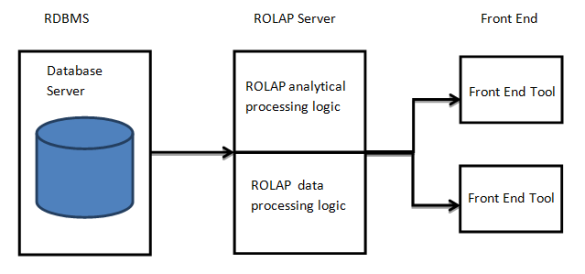Relational online analytical processing(ROLAP) provides OLAP functionality by using relation databases and familiar relation query tools to store and analyze multi-dimensional data. This approach builds on existing relational technologies and represents a natural extension to all those companies that already use relational database management systems within their organizations. ROLAP adds the following extensions to traditional RDBMS technology-
- Multidimensional data schema support within the RDBMS
- Data access language and query performance are optimized for multidimensional data
- Support for very large databases (VLDBs)
ROLAP Architecture:-
ROLAP tools are mainly 3-tier client/server product which includes the followings-
- End user tools.
- ROLAP server.
- Database server.

Advantages:-
- Can handle large amounts of data: The data size limitation of ROLAP technologies the limitation on data size of the underlying relational database. In other words, ROLAP itself places no limitation on data amount.
- Can leverage functionalities inherent in the relational database: Often, relational database already comes with a host of functionalities. ROLAP technologies, since they sit on top of the relational database, can therefore leverage these functionalities.
Disadvantages:-
- Performance can be slow: Because each ROLAP report is essentially a SQL query(or multiple SQL queries) in the relational database, the query time can be long if the underlying data size is large.
- Because ROLAP technology mainly relies on generating SQL statements to query the relational database, and SQL statements do not fit all needs (for example, it is difficult to perform complex calculations using SQL), ROLAP technologies are therefore traditionally limited by what SQL can do. ROLAP vendors have mitigated this risk by building into the tool out-of-the-box complex functions as well as the ability to allow users to define their own functions.
